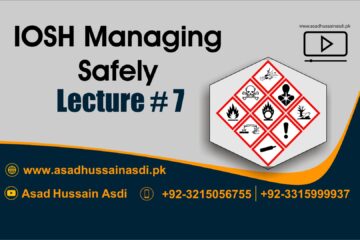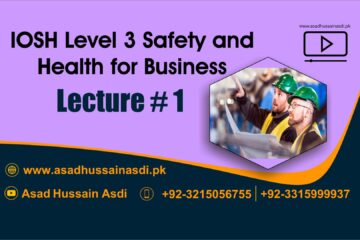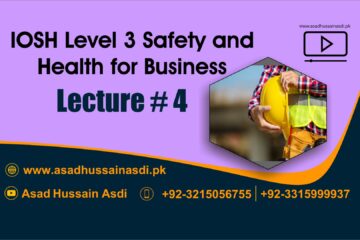ProQual Level 2 Diploma in Steel Erecting Course in Islamabad || Registration Open
Registration Open= +92-3315999937, +92- 3215056755 (WhatsApp Only)
cIntroduction
The aim of this qualification is to recognise the knowledge, skills and competence of
individuals who specialise in steel erecting in the construction and engineering industries.
The awarding organisation for this qualification is ProQual Awarding Body and the
regulatory body is the Office of Qualifications and Examinations Regulation (Ofqual). The
specification for these qualifications has been approved by the Welsh Government for use
by centres in Wales and by the Council for the Curriculum Examinations and Assessment
(CCEA) for use by centres in Northern Ireland.
This qualification has been accredited onto the Regulated Qualifications Framework (RQF).
Qualification Profile
Qualification title ProQual Level 2 Diploma in Steel Erecting
Ofqual qualification number 601/5675/2
Level Level 2
Total qualification time 420 hours
Guided learning hours 205
Assessment
Pass or fail
Internally assessed and verified by centre staff
External quality assurance by ProQual verifiers
Qualification start date 1/3/15
Qualification end date
Entry Requirements
There are no formal entry requirements for this qualification.
Centres should carry out an initial assessment of candidate skills and knowledge to identify
any gaps and help plan the assessment.
4
November 2017
Level 2 Diploma in Steel Erecting
Qualification Structure
Candidates must complete all of the Mandatory units; candidates may complete the
Additional unit but this will not count towards the qualification.
Mandatory Units
Unit
Reference
Number
Unit Title Unit
Level GLH
K/602/6329 Contribute to effective working relationships in steel erection 2 15
K/602/6332 Work safely and minimise risk in steel erection 2 20
M/602/6333 Identify and deal with hazards and emergencies in steel erection 3 30
T/602/6334 Move structural steel sections under supervision 2 40
A/602/6335 Install structural steelwork components 2 20
J/602/6337 Work safely at height on steel structures 2 40
L/602/6338 Assemble bolted joints in structural steelwork 2 20
Additional Unit
Unit
Reference
Number
Unit Title Unit
Level GLH
R/602/6339 Dismantle structural steelwork components 2 30
5
November 2017
Level 2 Diploma in Steel Erecting
Centre Requirements
Centres must be approved to offer this qualification. If your centre is not approved please
complete and submit form ProQual Additional Qualification Approval Application.
Staff
Staff delivering this qualification must be appropriately qualified and occupationally
competent.
Assessors/Internal Quality Assurance
For each competence-based unit centres must be able to provide at least one assessor and
one internal verifier who are suitably qualified for the specific occupational area. Assessors
and internal verifiers for competence-based units or qualifications will normally need to
hold appropriate assessor or verifier qualifications, such as:
- Award in Assessing Competence in the Work Environment
- Award in Assessing Vocationally Related Achievement
- Certificate in Assessing Vocational Achievement
- Award in the Internal Quality Assurance of Assessment Processes and Practices
- Certificate in Leading the Internal Quality Assurance of Assessment Processes and
Practices
Support for Candidates
Materials produced by centres to support candidates should:
- enable them to track their achievements as they progress through the learning
outcomes and assessment criteria;
- provide information on where ProQual’s policies and procedures can be viewed;
- provide a means of enabling Internal and External Quality Assurance staff to
authenticate evidence
6
November 2017
Level 2 Diploma in Steel Erecting
Assessment
Candidates must demonstrate the level of knowledge described in the unit. Assessment is
the process of measuring a candidate’s knowledge and understanding against the standards
set in the qualification.
Assessment guidance is included to assure consistency.
Each candidate is required to produce evidence which demonstrates their achievement of
all of the learning outcomes and assessment criteria for each unit.
Evidence can include: – assignments/projects/reports
– worksheets
– portfolio of evidence
– record of oral and/or written questioning
– candidate test papers
Learning outcomes set out what a candidate is expected to know, understand or be able to
do.
Assessment criteria specify the standard a candidate must meet to show the learning
outcome has been achieved.
Learning outcomes and assessment criteria for this qualification can be found from page 8.
Internal Quality Assurance
An internal quality assurance verifier confirms that assessment decisions made in centres
are made by competent and qualified assessors, that they are the result of sound and fair
assessment practice and that they are recorded accurately and appropriately.
Adjustments to Assessment
Adjustments to standard assessment arrangements are made on the individual needs of
candidates. ProQual’s Reasonable Adjustments Policy and Special Consideration Policy sets
out the steps to follow when implementing reasonable adjustments and special
considerations and the service that ProQual provides for some of these arrangements.
Centres should contact ProQual for further information or queries about the contents of the
policy.
7
November 2017
Level 2 Diploma in Steel Erecting
Results Enquiries and Appeals
All enquiries relating to assessment or other decisions should be dealt with by centres, with
reference to ProQual’s Enquiries and Appeals Procedures.
Certification
Candidates who achieve the requirements for qualifications will be awarded:
- A certificate listing the unit achieved, and
- A certificate giving the full qualification title –
ProQual Level 2 Diploma in Steel Erecting
Claiming certificates
Centres may claim certificates for candidates who have been registered with ProQual and
who have successfully achieved the requirements for a qualification. All certificates will be
issued to the centre for successful candidates.
Replacement certificates
If a replacement certificate is required a request must be made to ProQual in writing.
Replacement certificates are labelled as such and are only provided when the claim has
been authenticated. Refer to the Fee Schedule for details of charges for replacement
certificates.
8
November 2017
Level 2 Diploma in Steel Erecting
Learning outcomes and assessment criteria
Unit K/602/6329
Contribute to effective working relationships in steel erection
Learning Outcome – The learner
will: Assessment Criterion – The learner can:
1 Establish and maintain productive
working relationships.
1.1 Develop working relationships with different people in the
work environment such as: those for whom they are
responsible, those to whom they are responsible, clients,
colleagues, other tradespersons, suppliers, security/safety
personnel.
2 Deal with disagreements in an
amicable and constructive way so
that effective relationships are
maintained.
2.1 Accept the opinions of others in relation to work
activities.
2.2 Review different points of view on work related matters
in a positive and constructive way in order to maintain
working relationships and productivity.
2.3 Apply mediation (in accordance with the individual’s
responsibilities) in the event of disagreements between
third parties in order to maintain productive working
relationships.
3 Keep others informed about work
plans or activities which affect
them.
3.1 Use appropriate types of communication
(formal/informal, written, verbal) to clearly relay
important information to others.
4 Seek assistance from others in a
polite and courteous way without
causing undue disruption to
normal working activities.
4.1 Approach workplace colleagues / associates in an
appropriate manner and at an appropriate time, in order
to seek assistance on work related issues.
5 Respond in a timely and positive
way when others ask for help or
information.
5.1 Prioritise requests for help and information in relation to
wider work activities.
5.2 Clarify requests for help and information to identify
exactly what is required.
5.3 Ensure appropriate responses are provided within agreed
timescales.
6 Understand the importance of
creating and maintaining working
relationships.
6.1 Describe the individual’s responsibilities for creating and
maintaining working relationships and explain why it is
important to do so.
7 Understand problems affecting
relationships.
7.1 Describe different problems that can affect relationships,
and the actions that can be taken to deal with specific
difficulties.
8 Understand lines of
communication and
responsibilities.
8.1 Explain the individual’s responsibilities and the
responsibilities of others within the work location.
8.2 Describe the lines of communication that exist within the
individual’s working environment and explain the agreed
procedure for passing information.
9
November 2017
Level 2 Diploma in Steel Erecting
Assessment
Assessment of this unit will be by occupationally competent assessors approved by ProQual
They will gather sufficient evidence of competence from work-based activities on suitable
industry sites. Such methods may include discussions with candidates, the use of witness
testimony and the interview of witnesses as part of the assessment process.
No mandatory workplace observation is required for the Assessment Criteria.
10
November 2017
Level 2 Diploma in Steel Erecting
Unit K/602/6332
Work safely and minimise risk in steel erection
Learning Outcome – The learner will: Assessment Criterion – The learner can:
1 Understand health and safety
legislation, regulations and safe
working practices and procedures.
1.1 Explain the requirements of health and safety
legislation.
1.2 Explain the consequences for employers and
employees of not fulfilling their legal health and safety
responsibilities.
1.3 Explain the purpose and nature of risk assessments,
method statements, and permit to work systems, and
the relevance of local procedures and guidance notes.
1.4 Describe reporting lines and procedures.
2 Understanding personal site safety
responsibilities.
2.1 Describe how to recognise health safety training
needs, the procedure for requesting training and who
to ask for help in understanding the work instructions.
2.2 Describe how to get information relating to the safe
use of equipment and how to ensure the equipment is
used safely.
2.3 Describe how to recognise when personal protective
equipment should be used and how to select and use
the correct equipment for the work to be undertaken.
2.4 Describe different types of vibration injuries and
explain how they can be prevented.
2.5 Explain the importance of personal behaviour in
maintaining workplace standards.
2.6 Describe the checks which are needed to make sure
that portable electrical appliances are safe to use.
2.7 Describe what a safe system for electrical isolation
should include and why low voltage is generally safer
in relation to health and safety.
2.8 Describe the risks from over head cables and how to
control them.
2.9 Describe what must be done when carrying hazardous
substances in vehicles.
2.10 Describe where asbestos is likely to be found, what
should be done if it is thought to have been found and
how it is a risk to health.
3 Understand others site safety
responsibility.
3.1 Explain who is responsible for ensuring that
equipment is checked and safe to use.
3.2 Describe who is responsible and who must assess the
health and safety of people working on a client’s site.
3.3 Describe the legal rights and responsibilities of the
appointed safety representatives and the powers of
the regulatory inspectors.
11
November 2017
Level 2 Diploma in Steel Erecting
Learning Outcome – The learner will: Assessment Criterion – The learner can:
4 Know first aid procedures. 4.1 Describe the first aid procedures that typically apply in
the workplace.
4.2 Describe the aspects of first aid in the workplace that
all personnel are expected to know.
5 Understand evacuation procedures. 5.1 Describe how to work safely in an excavation.
5.2 Explain procedures for shutdown and evacuation and
state where procedures can be obtained.
6 Understand contingency reporting
documentation and systems.
6.1 Describe the contingency reporting documentation
and systems that are relevant to workplace activities.
7 Understand appropriate reporting
lines and procedures.
7.1 Explain how to comply with the various reporting lines
and procedures that apply in the working
environment.
Assessment
Assessment of this unit will be by occupationally competent assessors approved by ProQual
They will gather sufficient evidence of competence from discussions with candidates about
work-based activities on suitable industry sites. Such methods may include discussions
about product evidence and questioning.
No mandatory workplace observation is required for the Assessment Criteria.
12
November 2017
Level 2 Diploma in Steel Erecting
Unit M/602/6333
Identify and deal with hazards and emergencies in steel erection
Learning Outcome – The learner will: Assessment Criterion – The learner can:
1 Recognise industrial processes, tools,
equipment and materials that have
the potential to cause harm.
1.1 Identify different hazardous processes, tools,
equipment and materials which exist in the work
environment.
1.2 Identify hazardous industrial processes associated with
particular working environments.
2 Check for and identify potential
hazards in the workplace in line with
agreed and approved procedures.
2.1 Safely check for potential hazards in accordance with
agreed and approved procedures.
2.2 Identify potential hazards in the workplace and report
in accordance with approved procedures.
2.3 Minimise potential hazards using the criteria and
procedures specified in the risk control strategy.
3 Take appropriate action to minimise
the risk from hazards and
emergencies.
3.1 Take appropriate action upon identification of a hazard
or emergency.
3.2 Call for expert help using warning systems as
appropriate.
3.3 Follow shut down and evacuation procedures
promptly and correctly.
3.4 Deal safely with hazards and emergencies in
accordance with organisational policy and procedures.
3.5 Report in accordance with the overall risk control
strategy.
4 Understand health and safety
legislation, regulations and safe
working practices and procedures.
4.1 Explain the requirements of health and safety
legislation.
4.2 Explain the purpose and nature of risk assessments,
method statements, and permit to work systems, and
the relevance of local procedures and guidance notes.
4.3 Describe reporting lines and procedures.
5 Understand hazard spotting and
safety assessment methods and
techniques.
5.1 State where information on hazard spotting and safety
assessment methods and techniques can be found.
5.2 Describe the hazard spotting and safety assessment
methods and techniques, which apply in the work
location.
6 Understand types of hazards involving
processes, tools, equipment and
materials.
6.1 Describe common types of hazard associated with
processes, tools, equipment and materials.
6.2 State what the individuals’ responsibilities are in terms
of dealing with and notifying others of hazards.
7 Understand effects of hazards on
persons, property and the
environment.
7.1 Describe the effects of hazards on persons, property
and the environment.
8 Understand actions to minimise risk
from hazards.
8.1 Describe the types of actions required to deal with and
minimise the risks from different hazards.
13
November 2017
Level 2 Diploma in Steel Erecting
Assessment
Assessment of this unit will be by occupationally competent assessors approved by ProQual
They will gather sufficient evidence of competence from work-based activities on suitable
industry sites by discussions with candidates. Such methods may include discussions about
product evidence and questioning.
Competence at level 3 has to be demonstrated with:
- Level and extent of responsibility.
- Type of hazards and risks arising.
- Hazard checking methods to be used.
- The type of workplace and environment.
- Type of action to be taken.
No mandatory workplace observation is required the Assessment Criteria.
14
November 2017
Level 2 Diploma in Steel Erecting
Unit T/602/6334
Move structural steel sections under supervision
Learning Outcome – The learner will: Assessment Criterion – The learner can:
1 Work Safely at all times. 1.1 Identify a range of hazards.
1.2 Take appropriate action to minimise the risk from
hazards.
1.3 Refer safety related matters to appropriate
persons as required.
1.4 Work in accordance with relevant sections of the
Health and Safety at Work Act and its associated
regulations.
1.5 Work in accordance with the requirements of risk
assessments, permit to work systems.
2 Prepare work area, materials and
equipment to carry out the movement
structural steel sections.
2.1 Ensure that the work environment, equipment,
construction elements and materials are suitable
for the work activities to be undertaken.
2.2 Ensure that all necessary service supplies are
connected correctly and ready for use.
2.3 Ensure the work area and materials are prepared
to the required standards for the engineering
activity to be completed.
2.4 Select, obtain and prepare the appropriate tools
and equipment and check they are in a safe and
usable condition.
2.5 Agree and confirm load movement procedures
and method of signalling and communication
with relevant personnel.
2.6 Report completion of preparations in line with
organisational procedures.
2.7 Deal promptly and effectively with problems and
report those that cannot be solved.
3 Carry out the movement of structural steel
sections under supervision.
3.1 Select the appropriate slinging technique suitable
for the characteristics of the loads, the intended
lift and approved procedures and practices under
supervision.
3.2 Identify and clarify difficulties in carrying out the
slinging and movement of loads with the
appropriate person.
3.3 Attach lifting equipment in accordance with the
chosen slinging technique.
3.4 Confirm the slung load support and balance is
satisfactory and the load is secure prior to
movement.
3.5 Use agreed communication system to accurately
direct movement of load destination under
supervision.
15
November 2017
Level 2 Diploma in Steel Erecting
Learning Outcome – The learner will: Assessment Criterion – The learner can:
3.6 Monitor the stability of the load throughout
movement.
3.7 Ensure the load is positioned, set down, secured
before the lifting equipment is relaxed and
removed.
3.8 Deal promptly and effectively with problems and
report those that cannot be solved.
4 Carry out the necessary actions after the
movement of structural steel sections.
4.1 Reinstate the work area to a safe condition and
correctly dispose of waste materials.
4.2 Store re-usable materials and equipment in
accordance with appropriate procedures.
4.3 Complete all necessary documentation.
5 Understand Health and safety legislation,
regulations and safe working practices and
procedures.
5.1 Explain the requirements of health and safety
legislation.
5.2 Explain the purpose and nature of risk
assessments, method statements, and permit to
work systems, and the relevance of local
procedures and guidance notes.
5.3 Hazards and conditions that affect the lifting
activity.
5.4 Describe reporting lines and procedures.
6 Understand the work area, material and
equipment preparation and restoration
requirements for the movement of
structural steel sections.
6.1 Describe work area, material and equipment
preparation and restoration requirements and
methods.
6.2 Explain the consequences of incorrectly preparing
or restoring the work areas, material and
equipment.
6.3 Describe the types of equipment, construction
elements used and explain the care and control
procedures.
6.4 Describe types of lifting equipment in relation to
structural steel sections.
6.5 Describe lifting gear capabilities.
6.6 Describe types of defects and faults and discard
criteria for lifting equipment.
6.7 Describe coding and identification systems for
lifting equipment.
6.8 Explain material handling techniques and
preparation methods.
7 Understand the tools, terminology,
techniques and practices for the
movement of structural steel sections.
7.1 Describe how to interpret the instructions for the
movement of structural steel sections.
7.2 Describe relevant personnel involved with the
activity and methods used for signalling and
communication.
16
November 2017
Level 2 Diploma in Steel Erecting
Learning Outcome – The learner will: Assessment Criterion – The learner can:
7.3 Describe methods for slinging in relation to safe
working loads and angles of lift.
7.4 Describe procedures and practices for slinging
and signalling for the movement of structural
steel sections.
Assessment
Assessment of this unit will be by occupationally competent assessors approved by ProQual
They will gather sufficient evidence of competence either from work-based activities on
suitable engineering construction industry sites or from simulated activities approved by
ProQual.
The loads are to be standard loads and non complex simple moves and routine lifts.
Mandatory workplace observation is required for Assessment Criteria 2.4, 2.5, 3.1, 3.3, 3.4,
3.5, 3.6 and 3.7.
17
November 2017
Level 2 Diploma in Steel Erecting
Unit A/602/6335
Install structural steelwork components
Learning Outcome – The learner will: Assessment Criterion – The learner can:
1 Work Safely at all times. 1.1 Identify a range of hazards.
1.2 Take appropriate action to minimise the risk
from hazards.
1.3 Refer safety related matters to appropriate
persons as required.
1.4 Work in accordance with relevant sections of the
Health and Safety at Work Act and its associated
regulations.
1.5 Work in accordance with the requirements of
risk assessments, permit to work systems.
2 Prepare work area, materials and
equipment to erect structural steelwork
components.
2.1 Ensure that the work environment, equipment,
construction elements and materials are suitable
for the work activities to be undertaken.
2.2 Ensure that all necessary service supplies are
connected correctly and ready for use.
2.3 Ensure the work area is prepared to the required
standards for the engineering activity to be
completed.
2.4 Obtain and prepare the appropriate tools,
equipment and constructional element and
check they are in a safe and usable condition.
2.5 Report completion of preparations in line with
organisational procedures.
2.6 Deal promptly and effectively with problems and
report those that cannot be solved.
3 Erect structural steelwork components. 3.1 Determine what has to be done and how this will
be achieved.
3.2 Secure the construction elements in line with the
specification.
3.3 Securely fix any necessary temporary support
facilities.
3.4 Take appropriate measures to protect the
finished construction.
3.5 Check that the installation is complete and that
all components are free from damage.
3.6 Deal promptly and effectively with problems and
report those that cannot be solved.
4 Carry out the necessary actions after
completion of the erection of structural
steelwork components.
4.1 Reinstate the work area to a safe condition and
correctly dispose of waste materials.
4.2 Store re-usable materials and equipment in
accordance with appropriate procedures.
4.3 Complete all necessary documentation.
18
November 2017
Level 2 Diploma in Steel Erecting
Learning Outcome – The learner will: Assessment Criterion – The learner can:
5 Understand Health and safety legislation,
regulations and safe working practices and
procedures.
5.1 Explain the requirements of health and safety
legislation.
5.2 Explain the purpose and nature of risk
assessments, method statements, and permit to
work systems, and the relevance of local
procedures and guidance notes.
5.3 Describe reporting lines and procedures.
6 Understand the work area, material and
equipment preparation and restoration
requirements for the erection of structural
steelwork components.
6.1 Describe work area, material and equipment
preparation and restoration requirements and
methods.
6.2 Explain the consequences of incorrectly
preparing or restoring the work areas, material
and equipment.
6.3 Describe the types of equipment, construction
elements used and explain the care and control
procedures.
6.4 Explain material handling techniques and
preparation methods.
7 Understand the tools, terminology,
techniques and practices for the erection of
structural steelwork components.
7.1 Describe construction component installation
methods and techniques.
7.2 Explain methods of providing temporary support
during installation.
7.3 Explain the tools and methods used for checking.
Assessment
Assessment of this unit will be by occupationally competent assessors approved by ProQual
They will gather sufficient evidence of competence either from work-based activities on
suitable engineering construction industry sites or from simulated activities approved by
ProQual.
Mandatory workplace observation is required for Assessment Criteria: 2.3, 2.4, 3.1, 3.2, 3.3
and 3.5
19
November 2017
Level 2 Diploma in Steel Erecting
Unit J/602/6337
Work safely at height on steel structures
Learning Outcome – The learner will: Assessment Criterion – The learner can:
1 Work Safely at all times. 1.1 Identify a range of hazards.
1.2 Take appropriate action to minimise the risk from
hazards.
1.3 Refer safety related matters to appropriate
persons as required.
1.4 Work in accordance with relevant sections of the
Health and Safety at Work Act and its associated
regulations.
1.5 Work in accordance with the requirements of risk
assessments, permit to work systems.
2 Prepare work area, materials and
equipment to work safely at height on steel
structures.
2.1 Ensure that the work environment, equipment,
and materials are suitable for the work activities
to be undertaken.
2.2 Ensure that where appropriate identify and
implement site exclusion zones.
2.3 Ensure that work access is suitable and allows the
work to be carried out safely.
2.4 Ensure that all necessary service supplies are
connected correctly and ready for use.
2.5 Ensure the work area and materials are prepared
to the required standards for the engineering
activity to be completed.
2.6 Obtain and prepare the appropriate tools and
equipment and check they are in a safe and
usable condition.
2.7 Report completion of preparations in line with
organisational procedures.
2.8 Ensure the communication channels are selected
and established which are suitable for the work
to be undertaken.
2.9 Deal promptly and effectively with problems and
report those that cannot be solved.
3 Work safely at height on steel structures. 3.1 Ensure that access is gained in accordance with
laid down procedures.
3.2 Monitor the site to ensure the access method
continues to allow you to work safely.
3.3 Implement appropriate safety systems and
procedures to minimise the risk of injury to
personnel or assets should the lifting or support
fail.
20
November 2017
Level 2 Diploma in Steel Erecting
Learning Outcome – The learner will: Assessment Criterion – The learner can:
3.4 Ensure lifting and working at height is only
carried out when environmental and weather
conditions are suitable.
3.5 Take appropriate action where deployment of
access equipment cannot be executed safely.
3.6 Deal promptly and effectively with problems and
report those that cannot be solved.
4 Carry out the necessary actions after
completing working safely at height on
steel structures.
4.1 Reinstate the work area to a safe condition and
correctly dispose of waste materials.
4.2 Store re-usable materials and equipment in
accordance with appropriate procedures.
4.3 Complete all necessary documentation.
5 Understand Health and safety legislation,
regulations and safe working practices and
procedures.
5.1 Explain the requirements of health and safety
legislation.
5.2 Explain the purpose and nature of risk
assessments, method statements, and permit to
work systems, and the relevance of local
procedures and guidance notes.
5.3 Describe reporting lines and procedures.
6 Understand the work area, material and
equipment preparation and restoration
requirements for working safely at height
on steel structures.
6.1 Describe work area, material and equipment
preparation and restoration requirements and
methods.
6.2 Explain the consequences of incorrectly preparing
or restoring the work areas, material and
equipment.
6.3 Describe the types of equipment, construction
element, materials and consumables used and
explain the care and control procedures.
6.4 Explain material handling techniques and
preparation methods.
7 Understand the tools, equipment,
terminology, techniques and practices for
working safely at height on steel
structures.
7.1 Describe access and egress requirements for
working at height.
7.2 Describe how to select and use types of fall arrest
equipment.
Assessment
Assessment of this unit will be by occupationally competent assessors approved by ProQual
They will gather sufficient evidence of competence either from work-based activities on
suitable engineering construction industry sites or from simulated activities approved by
ProQual.
Mandatory workplace observation is required for Assessment Criteria: 2.4, 2.5, 3.1, 3.2, 3.3,
3.4 and 3.5
21
November 2017
Level 2 Diploma in Steel Erecting
Unit L/602/6338
Assemble bolted joints in structural steelwork
Learning Outcome – The learner will: Assessment Criterion – The learner can:
1 Work Safely at all times. 1.1 Identify a range of hazards.
1.2 Take appropriate action to minimise the risk
from hazards.
1.3 Refer safety related matters to appropriate
persons as required.
1.4 Work in accordance with relevant sections of the
Health and Safety at Work Act and its associated
regulations.
1.5 Work in accordance with the requirements of
risk assessments, permit to work systems.
2 Prepare work area, materials and
equipment to assemble bolted joints in
structural steelwork.
2.1 Ensure that the work environment, equipment
and materials are suitable for the work activities
to be undertaken.
2.2 Ensure that all necessary service supplies are
connected correctly and ready for use.
2.3 Ensure the work area and materials are prepared
to the required standards for the engineering
activity to be completed.
2.4 Obtain and prepare the appropriate tools and
equipment and check they are in a safe and
usable condition.
2.5 Report completion of preparations in line with
organisational procedures.
2.6 Deal promptly and effectively with problems and
report those that cannot be solved.
3 Assemble bolted joints in structural
steelwork.
3.1 Follow the relevant instructions, assembly
drawings and specifications.
3.2 Assemble the components in the correct
positions in line with appropriate methods and
techniques.
3.3 Secure the components using the specified
connectors and securing devices.
3.4 Check the completed assembly to ensure all
operations are completed and the finished
assembly meets the specification.
3.5 Deal promptly and effectively with problems and
report those that cannot be solved.
4 Carry out the necessary actions after
completing assembling bolted joints in
structural steelwork.
4.1 Reinstate the work area to a safe condition and
correctly dispose of waste materials.
4.2 Store re-usable materials and equipment in
accordance with appropriate procedures.
4.3 Complete all necessary documentation.
22
November 2017
Level 2 Diploma in Steel Erecting
Learning Outcome – The learner will: Assessment Criterion – The learner can:
5 Understand Health and safety legislation,
regulations and safe working practices and
procedures.
5.1 Explain the requirements of health and safety
legislation.
5.2 Explain the purpose and nature of risk
assessments, method statements, and permit to
work systems, and the relevance of local
procedures and guidance notes.
5.3 Describe reporting lines and procedures.
5.4 Describe the hazards and risks associated with
the use of powered access equipment
6 Understand the work area, material and
equipment preparation and restoration
requirements for assembling bolted joints
in structural steelwork.
6.1 Describe work area, material and equipment
preparation and restoration requirements and
methods.
6.2 Explain the consequences of incorrectly
preparing or restoring the work areas, material
and equipment.
6.3 Describe the types of equipment, materials and
consumables used and explain the care and
control procedures.
6.4 Describe the conditions for positioning, setting
up and using selected power access equipment.
6.5 Explain equipment handling techniques and
procedures.
7 Understand the tools, terminology,
techniques and practices for assembling
bolted joints in structural steelwork.
7.1 Explain the principles, uses and conventions of
engineering drawings, and related specifications.
7.2 Describe assembly methods and techniques.
7.3 Describe how to identify defects in products and
assets.
7.4 Describe compliance checking methods and
techniques.
7.5 Describe quality control procedures and
recognition of assembly defects.
Assessment
Assessment of this unit will be by occupationally competent assessors approved by ProQual
They will gather sufficient evidence of competence either from work-based activities on
suitable engineering construction industry sites or from simulated activities approved by
ProQual.
Mandatory workplace observation is required for Assessment Criteria; 2.4, 3.1, 3.2, 3.3 and
3.4
23
November 2017
Level 2 Diploma in Steel Erecting
Unit R/602/6339
Dismantle structural steelwork components
Learning Outcome – The learner will: Assessment Criterion – The learner can:
1 Work Safely at all times. 1.1 Identify a range of hazards.
1.2 Take appropriate action to minimise the risk
from hazards.
1.3 Refer safety related matters to appropriate
persons as required.
1.4 Work in accordance with relevant sections of the
Health and Safety at Work Act and its associated
regulations.
1.5 Work in accordance with the requirements of risk
assessments, permit to work systems.
2 Prepare work area, materials and
equipment to dismantle structural
steelwork components.
2.1 Ensure that the work environment, equipment
and materials are suitable for the work activities
to be undertaken.
2.2 Ensure that all necessary service supplies are
connected correctly and ready for use.
2.3 Ensure the work area and materials are prepared
to the required standards for the dismantling
activity to be completed.
2.4 Obtain and prepare the appropriate tools and
equipment and check they are in a safe and
usable condition.
2.5 Report completion of preparations in line with
organisational procedures.
2.6 Deal promptly and effectively with problems and
report those that cannot be solved.
3 Dismantle structural steelwork
components.
3.1 Establish and where necessary support
components before removal of securing devices.
3.2 Remove the structural steelwork components in
the correct sequence using approved equipment,
methods and techniques.
3.3 Identify any damage or defects in any re-useable
elements and store them for re-use in an
appropriate location.
3.4 Inform the appropriate people when activities
are complete.
3.5 Deal promptly and effectively with problems and
report those that cannot be solved.
4 Carry out the necessary actions after
completing dismantling structural
steelwork components.
4.1 Reinstate the work area to a safe condition and
correctly dispose of waste elements.
4.2 Store re-usable materials and equipment in
accordance with appropriate procedures.
4.3 Complete all necessary documentation.
24
November 2017
Level 2 Diploma in Steel Erecting
Learning Outcome – The learner will: Assessment Criterion – The learner can:
5 Understand Health and safety legislation,
regulations and safe working practices and
procedures.
5.1 Explain the requirements of health and safety
legislation.
5.2 Explain the purpose and nature of risk
assessments, method statements, and permit to
work systems, and the relevance of local
procedures and guidance notes.
5.3 Describe reporting lines and procedures.
5.4 Describe the hazards and risks associated with
the use of powered access equipment
6 Understand the work area, material and
equipment preparation and restoration
requirements for dismantling structural
steelwork components.
6.1 Describe work area, material and equipment
preparation and restoration requirements and
methods.
6.2 Explain the consequences of incorrectly
preparing or restoring the work areas, material
and equipment.
6.3 Describe the types of equipment, components,
materials and consumables used and explain the
care and control procedures.
6.4 Explain equipment handling techniques and
procedures.
7 Understand the tools, terminology,
techniques and practices for dismantling
structural steelwork components.
7.1 Describe the types of application of construction
components
7.2 Describe construction component dismantling
methods and techniques.
7.3 Describe methods and techniques for providing
temporary support during dismantling.
7.4 Describe reporting lines and procedures.
Assessment
Assessment of this unit will be by occupationally competent assessors approved by ProQual
They will gather sufficient evidence of competence either from work-based activities on
suitable engineering construction industry sites or from simulated activities approved by
ProQual.
Mandatory workplace observation is required for Assessment Criteria; 2.4, 3.1, 3.2, 3.3 and
3.4






















